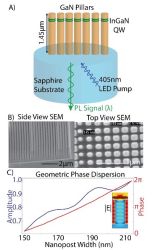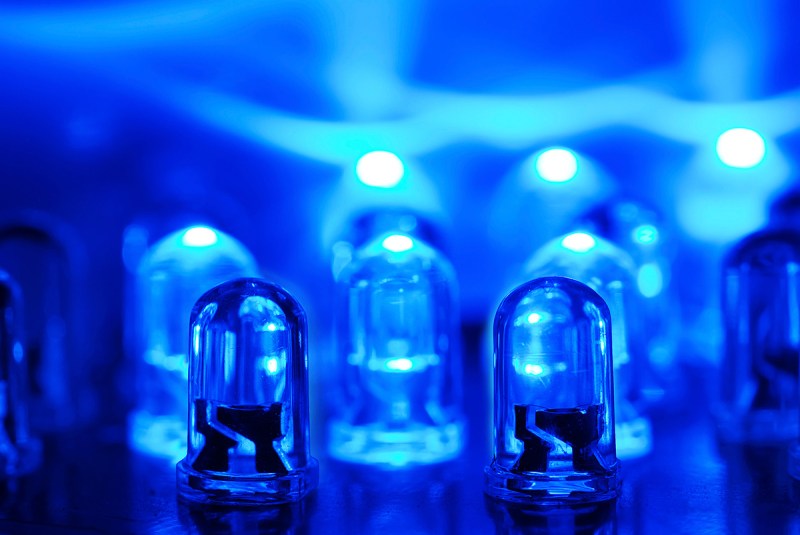Light-emitting diodes (LEDs) are not exactly new technology, but their use over time has evolved from rather dim replacements of incandescent signal lights in control panels to today’s home lighting. Although LEDs have the reputation of being power-efficient, there is still a lot of efficiency to be gained.
UC Santa Barbara researchers [Jonathan Schuller] and his team found that a large number of the photons that are generated never make it out of the LED. This means that the power that was used to generate these photons was essentially wasted. Ideally one would be able to have every single photon successfully make it out of the LED to contribute to the task of illuminating things.
 In their paper titled ‘Unidirectional luminescence from InGaN/GaN quantum-well metasurfaces‘ (pre-publication Arxiv version) they describe the problem of photon emission in LEDs. Photons are normally radiated in all directions, causing a ‘spray’ of photons that can be guided somewhat by the LED’s packaging and other parameters. The challenge was thus to start at the beginning, having the LED emit as many photons in one direction as possible.
In their paper titled ‘Unidirectional luminescence from InGaN/GaN quantum-well metasurfaces‘ (pre-publication Arxiv version) they describe the problem of photon emission in LEDs. Photons are normally radiated in all directions, causing a ‘spray’ of photons that can be guided somewhat by the LED’s packaging and other parameters. The challenge was thus to start at the beginning, having the LED emit as many photons in one direction as possible.
Their solution was the use of a metasurface-based design, consisting out of gallium nitride (GaN) nanorods on a sapphire substrate. These were embedded with indium gallium nitride (InGaN) quantum wells which emit the actual photons. According to one of the researchers, the idea is based on subwavelength antenna arrays already used with coherent light sources like lasers.
With experiments showing the simulated improvements, it seems that this research may lead to even brighter, more efficient LEDs before long if these findings translate to mass production.
(Thanks, Qes)















What was that type of coherent LED that you could get a couple or three decades back? It was used for aligning home built laser tubes.
What have you been smoking…
Build Your Own Laser, Phaser, Ion Ray Gun & Other Working Space-age Projects
That’s great news, all we need is even brighter LEDs on our devices!
But once your router has charred spots on the ceiling where its LEDs point, then they won’t reflect back into the room so much.
Unless you move it, that could be a good thing. Just don’t aim your router at the curtains.
They could be used to replace lasers in DVD players… if those are still a thing.
Why is everybody so concerned with brighter LEDs? Don’t you realize that this means less heat per lumen? Heat is a serious problem for LED lighting, because it reduces life and realiability.
And btw, more maximum brightness is not a bad thing either.
I get PTSD thinking about 0603 blue LEDs
LEDs at low power levels can actually exceed 100% efficiency.
https://phys.org/news/2012-03-efficiency.html
If you’re running around 30 picowatts, the diode junction starts working as a peltier element and gains additional energy by cooling its surroundings.
All those B movie cryo-effects with blue light might have been on the right track???
“before long if these findings translate to mass production.”
I’d be curious how much this improved design costs, both in raw materials and manufacturing equipment. If it makes the LED 5% brighter at 500% the manufacturing cost I don’t expect rapid adoption of the technology. It’s still super cool but I’m going to guess some of this is rather expensive to make seeing as they just did simulations.
On the other hand if it’s the same brightness for even 10-15% less energy I can see battery powered devices using these for things like LCD backlights as long as the costs aren’t in the “dollar per LED” range.
Blue LED used to be in that range.
The first blue LEDs I used were in the $25 per LED range. IIRC, Volkswagen was a key reason for the price declining because under EU regulations, automobiles had to have a blue light for something in particular and VW wanted to use all LEDs instead of bulbs.
It’s the standard indicator for long beams.
Blue LED were very useful to cheat the pollution detectors… But I didn’t say a word.
High end flashlights have lots of other costs besides the LED, so they probably wouldn’t increase in price too much with new tech.
That’s nothing!
It can take a photon over 100,000 years before it leaves the Sun!
B^)
https://www.abc.net.au/science/articles/2012/04/24/3483573.htm
Whoa, when did primitive humans give up animism and take up sun worship, 60,000 years ago? In 40,000 years we’ll see some shit.
Thankfully they aren’t coherent like laser.
Yes but the neutrinos made at the same time leave immediately as matter hardly interacts with them at all so their flux levels tell you in advance what the sun is going to do luminosity wise in the far future. Handy that, having 100k years warning of the sun changing enough to cause harm to life on Earth.
When they get the 7.5 minute neutron flux warning of the Sun suddenly going nova, do you think they’ll tell us?
No, there is not many things to do in that time, 2 favorite songs or other nice activity and that’s it ;)
About a third of the way through Shine On You Crazy Diamond…
Just enough time to set the controls for the heart of the sun.
You know you would go through the playlist starting and changing songs until the last seconds, coming up with even better songs to play
Make it large enough and you have a photon drive for a space ship because light has inertia and “photon recoil” really is a thing. In the meantime we will have even more unreasonably bright blue LEDs to destroy our night vision with, yay I am so thrilled I may just go and scatter lego on the floor and have a little dance.
Can’t wait for those 50000 lumen LEDs for my car. 20000 isn’t enough :P
Anybody not wearing 2 million sunblock is gonna have a real bad day.
I wonder if this process could be used in reverse to make more efficient solar cells?
probably not…you want a solar panel to convert as much energy as it can, so a narrow bandwidth of light interaction is not something you want to see in one…
Unless you use an intermediate like phosphors that glow a specific color for varying types of illumination.